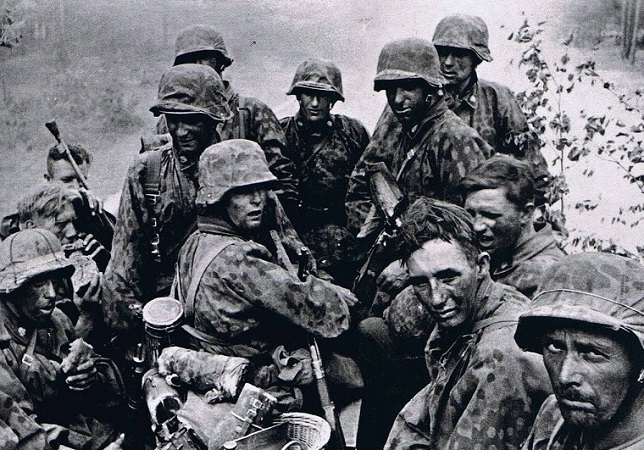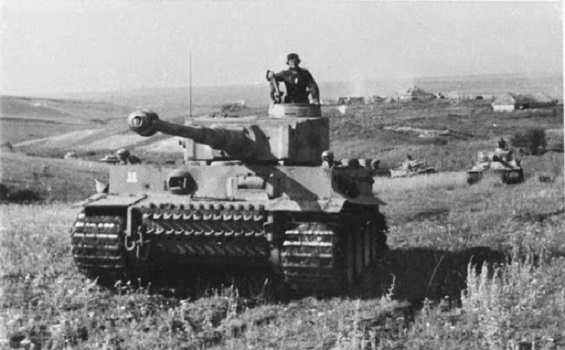● ● ●
In the
months following its catastrophic defeat at Stalingrad, the
German Army strained every nerve and muscle to replace and
rebuild its depleted formations. Priority was given to the
mobile forces: the panzer and motorized infantry
divisions—the latter retitled panzer grenadier divisions in
late 1942. The combat divisions of the
Waffen-SS,
which had been heavily engaged on the Eastern Front, were
included in the rehabilitation program. In matters of
organization, equipment and training they came under the
authority of Colonel-General Heinz Guderian, the Army’s
leading tank expert, whom Hitler had appointed as
Inspector-General of Armored Troops (Generalinspekteur
der Panzertruppen)
on 1 March 1943.
The four
existing Waffen-SS
motorized divisions—now called panzer grenadier
divisions—were rebuilt in accordance with a new table of
organization and equipment that effectively transformed them
into panzer divisions. They resembled their Army
counterparts but had various extra units: an assault gun
battalion, motorcycle infantry and engineer companies in the
panzer grenadier regiments, rocket artillery batteries, etc.
Four additional
Waffen-SS
panzer divisions were in process of formation and more were
planned—though in the event only three were added to the
Waffen-SS
order of battle as panzer divisions, the others becoming
panzer grenadier divisions instead. At this time all
divisions were numbered, so that their formal
title became, for example, 3. SS-Panzerdivision
Totenkopf.
The
accompanying diagram depicts the authorized organization of
the 1. SS-Panzerdivision
Leibstandarte SS Adolf Hitler.
As the
senior division of the
Waffen-SS
the Liebstandarte
was especially favored and had various extras tucked away
here and there, e.g. regimental antitank companies and a
larger armored reconnaissance battalion. The
5. SS-Panzerdivision
Wiking
had no
rocket launcher batteries, its artillery was all towed, and
its armored reconnaissance battalion was smaller than those
of the other existing divisions. The three new panzer
divisions could not, due to equipment shortages, be
organized to standard; only the
12. SS-Panzerdivision Hitlerjugend
came
close. None of the SS panzer divisions actually received the
heavy panzer company (Panzer VI Tiger tanks) that the new
table of organization specified.

Infantry of the Waffen-SS wearing their
distinctive camouflage smock and helmet cover. (Bundesarchiv)
The new
panzer grenadier divisions had much the same organization as
the panzer divisions, minus the panzer regiment. None of
their panzer grenadier battalions received armored
halftracks. The 17th SS Panzer Grenadier Division, raised in
late 1943, was typical. It arrived in France short of motor
vehicles and was equipped there with captured and
requisitioned French trucks. The
Waffen-SS
panzer grenadier divisions were supposed to have a battalion
of medium tanks but the 17th had to make do with an assault
gun battalion instead. One of its artillery battalions
should have been self-propelled but the necessary equipment
was unavailable and all artillery was motor towed. Nor were
the division's troops of the same high quality as those of
the older SS divisions. Most of its original cadre came from
replacement units or were conscripts, including a large
contingent of ethnic Germans from Romania. There were also a
number of French volunteers.
Also
raised at this time were four
Waffen-SS
panzer corps to command its divisions. This in turn
necessitated the formation of nondivisional corps troop
units, such as were designated
Heerestruppen
(General Headquarters Troops) by the Army. Units of this
type included heavy artillery and rocket artillery
battalions, heavy tank battalions, assault gun battalions,
motorcycle infantry battalions and engineer battalions. The
corps used them to augment its subordinate divisions as
necessary, e.g. by allotting extra artillery to divisions
participating in an attack. The
Waffen-SS
designated them as Special Troops of the
Reichführer-SS
(Sondertruppen der
RFSS).
Thus by
late 1943 there were seven
Waffen-SS
panzer divisions:
Liebstandarte, Das Reich, Totenkopf, Wiking, Hohenstaufen,
Frundsberg
and Hitlerjugend.
These were supplemented by four panzer grenadier
divisions: Polizei, Nordland, Reichführer-SS and
Götz von Berlichingen.
There were also a number of motorized assault brigades (Sturmbrigaden)—actually
battle groups created by attaching extra units, e.g. an
assault gun company, to a panzer grenadier battalion or
regiment.

Panzer VI heavy tanks of the Waffen-SS
in Russia during the Battle of Kursk, July 1943 (Bundesarchiv)
In addition
to mechanized units, the Waffen-SS embodied a number of
other formations. At the end of 1943
these consisted of three mountain
infantry divisions (Gebirgs-Divisionen), a
cavalry division and two infantry divisions. One of the
latter was manned by Latvians and the other was the original
Polizei Division that had been formed in 1939 with
Order Police personnel. Eventually it was merged with the
new 4. SS-Polizei-Panzergrenadier-Division.
One of the mountain
infantry divisions—13. Waffen-Gebirgs-Division der
SS “Handschar” (Kroatische Nr. 1)—was
manned by Bosnian Muslims with a leavening of Catholic
Croats and ethnic Germans (Volksdeutsch)
resident in former Yugoslavia. This was the first
Waffen-SS division to
be raised with foreign personnel.
In the last two years of
the war the Waffen-SS
rose to a nominal strength of 38 divisions. But many of
them, raised on an emergency basis, had the actual strength
of brigades or regiments. Their personnel came from here,
there and everywhere: France, Belgium the Netherlands,
Italy, Hungary, Croatia, Ukraine, Estonia,
Volksdeutsch from all
over Europe. To distinguish them from the original
Waffen-SS divisions
they were titled SS-Freiwilligen Division (SS
Volunteer Division) or Waffen-Grenadier-Division der SS.
Perhaps the most
notorious of these miscellaneous formations was the
Dirlewanger Brigade (SS-Sturmbrigade
Dirlewanger).
It was originally formed in 1940 with convicts who'd been
convicted of poaching, and was placed under the command of
Oskar Dirlewanger, an alcoholic
criminal sadist who became known as the most evil man in the
SS. The
ranks of the Dirlewanger Brigade were
soon filled with violent criminals of all kinds, and on the
Eastern Front it compiled a record of atrocity that even SS
senior officers found disturbing. During the Warsaw uprising
(August 1944) the brigade carried out repeated
massacres of Polish civilians, including 500 children on one
occasion. Early in 1945 the brigade was redesignated as the
36. Waffen-Grenadier-Division der SS,
fighting its last battles in the defense of Berlin.
Dirlewanger
himself, who during the battle had been wounded for the
twelfth time, was captured by the French Army in June 1945
and died in its custody—allegedly being done to death by
vengeful Polish soldiers.
During the Nurenburg
Trials the Waffen-SS was declared a criminal
organization due to the numerous war crimes committed by its
units, and its status as part of the larger SS organization.
However, men who'd been conscripted into the Waffen-SS
and had committed no war crimes were granted an exemption.
As things turned out most veterans of the Waffen-SS went on to
live normal lives in postwar West Germany, many receiving
pensions from the government and some even serving in the
Bundeswehr, the army of the new democratic state. In the
former German Democratic Public (East Germany) the regime's
official anti-fascist stance served as a cover for the state
security services' extensive employment of former Nazis,
including SS members.
● ● ●